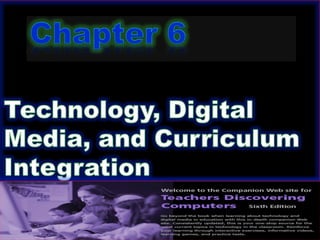
Presentation1
- 14. Cooperative Learning Cooperative learning refers to a method of instruction where students work together in groups to achieve standards and related learning objectives. Cooperative classroom activities are student-centered with the teacher serving as a facilitator and the students as information seekers. Higher-order thinking skills are the abilities to solve problems, engage in critical thinking, and to interpret and solve complex issues.
- 15. Role of Computers Teacher must plan carefully for the use and integration of computers and technologies in the classroom. Teachers must decide what technology is appropriate to achieve the desired goal. How your technology is integrated depends largely on how much Technology that you have in your classroom or at your school
- 16. One Computer Classroom: The teacher must plan to maximize the effectiveness of that one computer Two Computer Classroom: The teacher must develop a strategy to maintain there usage such as keeping one for research on the internet and web-based projects and use the other as a student writing center. More than two computers: Teachers who have several computers may find that arranging them into a single learning center or into several learning centers, through which groups of students can rotate as they complete projects or activities, provides an environment for productive use of the computers. Wireless Mobile Lab: A portable cart with wireless notebook computers that can be transported from one classroom to another.
- 17. KWL/KWHL This is an instructional planning tool for teachers to help in identifying student understanding of curriculum standards and related objectives. K - What the students already K now W - What the students W ant to know L - What the students will L earn K - What the students already K now W - What the students W ant to know H - H ow the students will learn L - What the students will L earn
- 18. The Assure Model The assure model was developed in the late 1990’s as a procedural guide for planning and delivering instruction that integrates technologies and media into the teaching process. A- Analyze the learner S- State objectives S- Select methods, media, and materials U- Utilize methods, media, and materials R- Require learner participation E- Evaluate and revise
- 19. Analyze The Learner: Knowing your learner’s skill level is important. Some students may come into your classroom with academic knowledge and technology skills that others may not have. Teachers should plan for this situation. Know your audience and consider the diverse differences in the student population you are teaching.
- 20. State Objectives Student objectives are statements of the type of skills and knowledge you expect students to be able to demonstrate at the end of instruction. When you have clear student objectives, you can select your materials and determine the focus and purpose of the lesson or project more wisely.
- 21. Select Methods, Media, and Materials Selection of methods, media and materials includes three steps, which are: 1. Decide on the method of instruction 2. Choose the media format that is appropriate for the method 3. Select, modify, update or design materials for the instruction
- 22. Utilize Methods, Media, and Materials Teachers should preview all media and materials they are planning to use, including videos, digital media, and Web sites. Although a software company may advertise that a particular product contains the correct content for your objectives, you, as the teacher, must evaluate the content of all the software
- 23. Require Learner Participation The most effective learning situations are those that require active learning and ask learners to complete activities that build mastery toward the learning objectives. Classroom lessons should motivate students to be active learners who are involved in the process of learning, such as practicing, performing, solving, building, creating, and manipulating.
- 24. Evaluate and Revise At the end of a project or lesson, it is important to evaluate all aspects of the lesson, instruction, or learning experience. Evaluation- the method of appraising or determining the significance or worth of an item Evaluation Process- assessing learning objectives, reviewing, critiquing the learners work and works based on specific standards, and evaluating reviews of the materials used. Reflective Instruction- thinking back on the components of the teaching and learning process and determining the effectiveness of the learner outcomes and the use of technology during the process.
- 26. Bibliography Shelly, Gary B. "Technology, Digital Media, and Curriculum Integration." Teachers Discovering Computers: Integrating Technology and Digital Media in the Classroom . 5th ed. Boston, MA: Thomson/Course Technology, 2008. 323-66. Print.